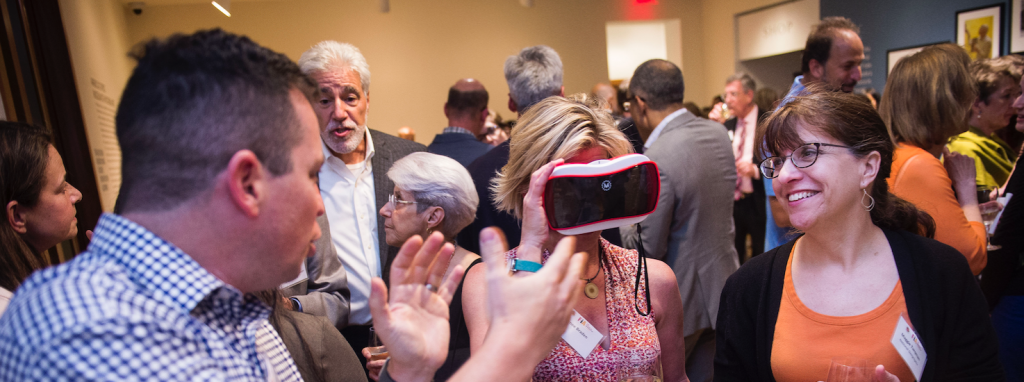The Future of Virtual Reality
This is an insight written by Esther Kaufman on an event cosponsored by The Bahá’í Chair for World Peace and organized by the Future of Information Alliance on June 6, 2017 at the Phillips Collection.
The Bahá’í Chair for World Peace recently cosponsored the Future of Information Alliance (FIA) event on the future of virtual reality (VR).
The event was organized in partnership with the University of Maryland and the Phillips Collection and brought together innovators Amitabh Varshney (UMD), Dan Russell (Google), and Maribel Perez Wadsworth (Gannett).

From L-R: Anne Rose, Sheri Parks, Hoda Mahmoudi, Lucy Dalglish, Amitabh Varshney, Maribel Perez Wadsworth, Allison Druin, Ira Chinoy, Dan Russell
What is Virtual Reality?
To clarify the jargon associated with virtual reality, Dan Russell defined the different formats. Virtual reality is the collection of real-world images stitched together for a 360-degree view, and this is differentiated from augmented reality (AR), which is a combination of both real-world and digitalized images.
Together, the speaker’s presentations and the work they have been doing illuminated the power of both VR and AR in bringing advances to the diverse fields of journalism, arts, education, and defense.
Limitless Applications for Virtual Reality
Substantial investment from several esteemed institutions, such as the National Science Foundation and the National institute of Standards and Technology in Dr. Varshney’s VR research, suggests that his confidence in VR to serve as the next revolutionary medium may not be far off. Perhaps this is because his team’s VR research has already been applied in improving children’s education, in advancing medical diagnostic tools, and even in improving memory development.
Dr. Varshney gave an example of a common educational use of VR that has allowed hundreds of students across the nation to experience historical environments with 360-degree views of detailed context with the help of VR devices. This has allowed students to experience history from a very personal and perhaps even empathetic perspective.
Transforming Journalism
While academic research continues to discover the depth of VR’s potential, this technology is already being utilized in the field of journalism. Maribel Wadsworth emphasized the power a 360-degree reality has in allowing viewers to develop their own, unbiased perspectives on the latest news stories. In other words, it removes imagery bias that is common critique amongst journalistic pieces.
Wadsworth used the recent, and topical example of the controversy of crowd-size images at presidential campaign rallies to emphasize the power a 360-degree view may have.
Removing Bias
In addition to removing bias, VR also increases the number of perspectives developed in perceiving any single story. In this way, VR technology is able to better democratize media with audiences that are more informed and share a variety of perspectives.

Guests at the event experiencing VR created by students in the FiA Spark Grant Program
In an era of increasing polarization, this might be the visual needed to push audiences to engage in productive conversation with one another.
With New Technology Comes Immense Responsibility
Although the potential VR has in confronting the social challenges of our era seem remarkable, Dan Russell warns that with new technology comes immense responsibility.
As models of what are real may be easily manipulated it becomes critical to educate users on what exactly they are viewing and how it may stray from reality.
In this case it seems responsibility may be a fair trade-off for an invention whose beneficial societal contributions, across disciplines, seem almost limitless.
About the Author:
 Esther Kaufman is recent Economics graduate from the University of Maryland with a minor in Global Terrorism Studies. She is interested in the effects of economic policy on issues such as equality, welfare and radicalization of individuals in society.
Esther Kaufman is recent Economics graduate from the University of Maryland with a minor in Global Terrorism Studies. She is interested in the effects of economic policy on issues such as equality, welfare and radicalization of individuals in society.
Photo Credit: Lisa Helfert
For more about the event, and to learn more about the Bahá’í Chair visit our website and watch our video.
